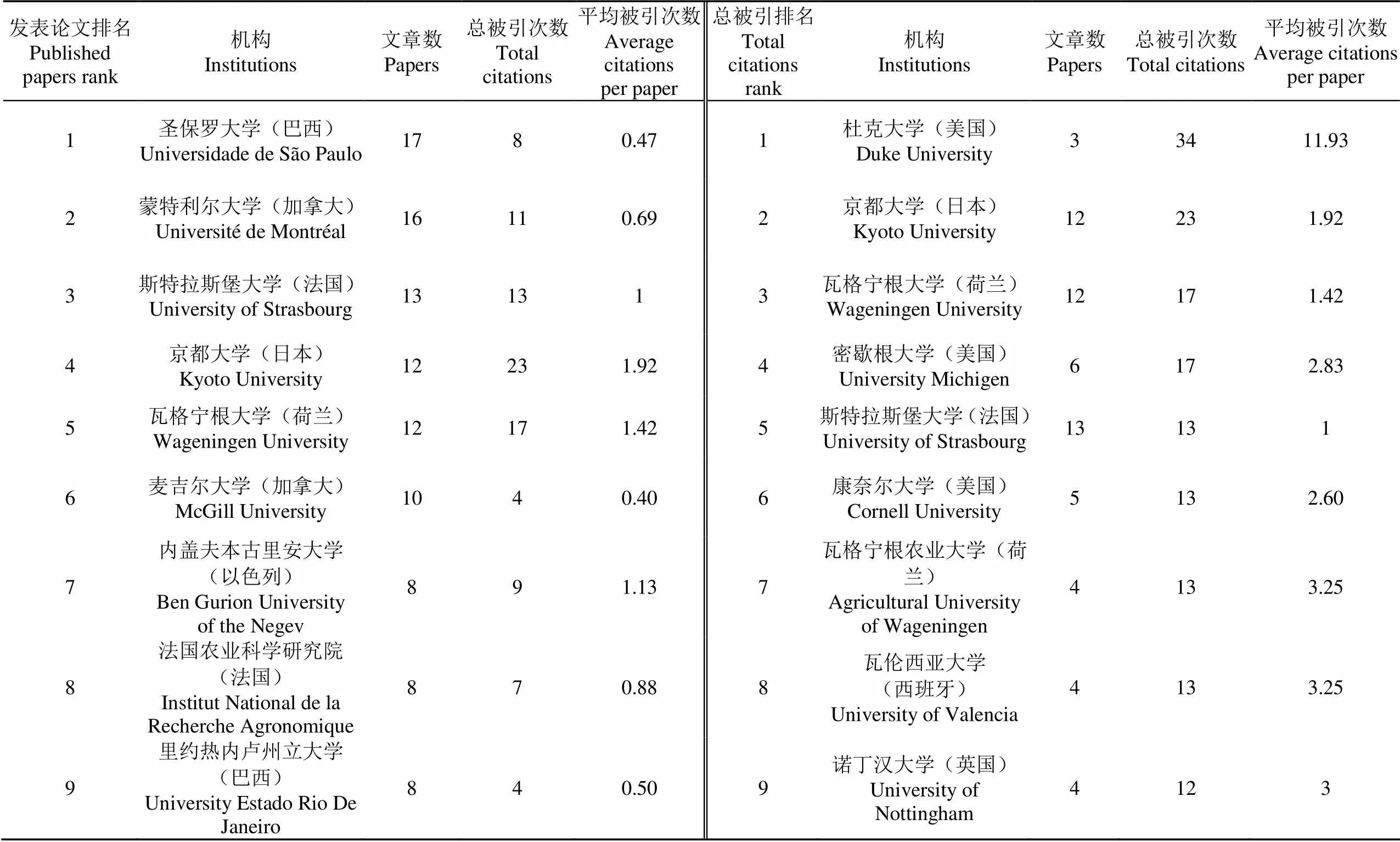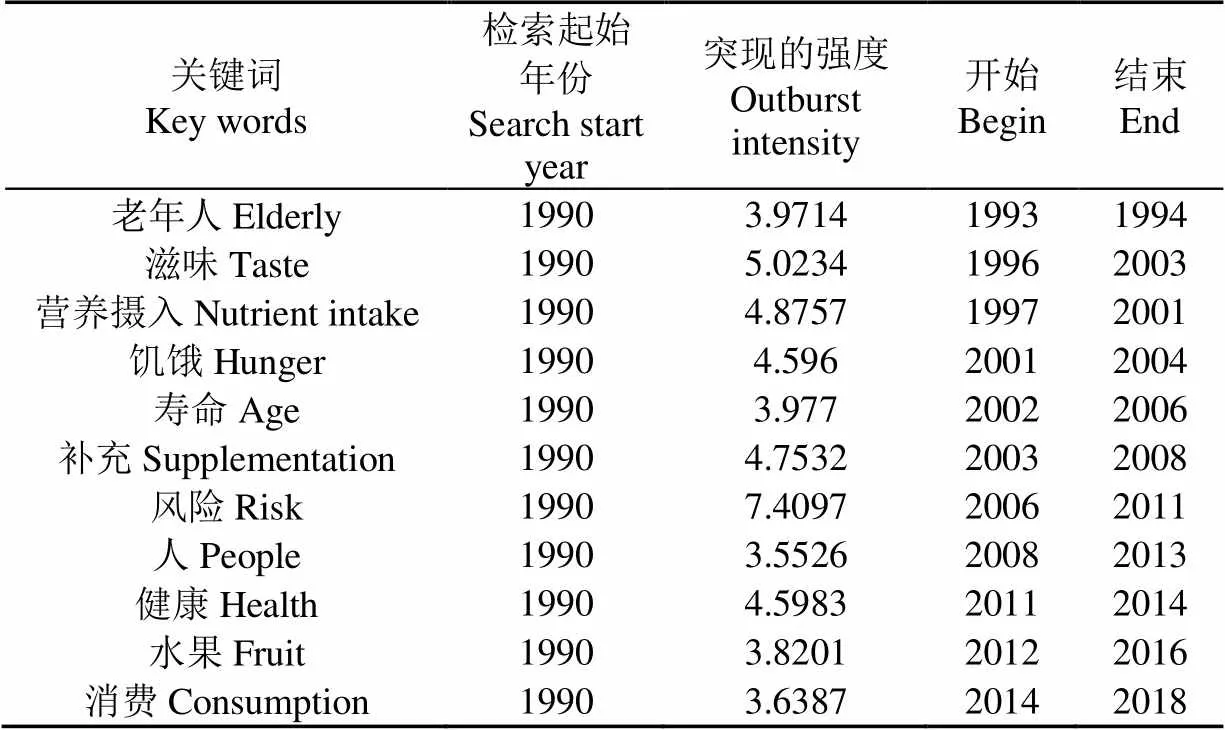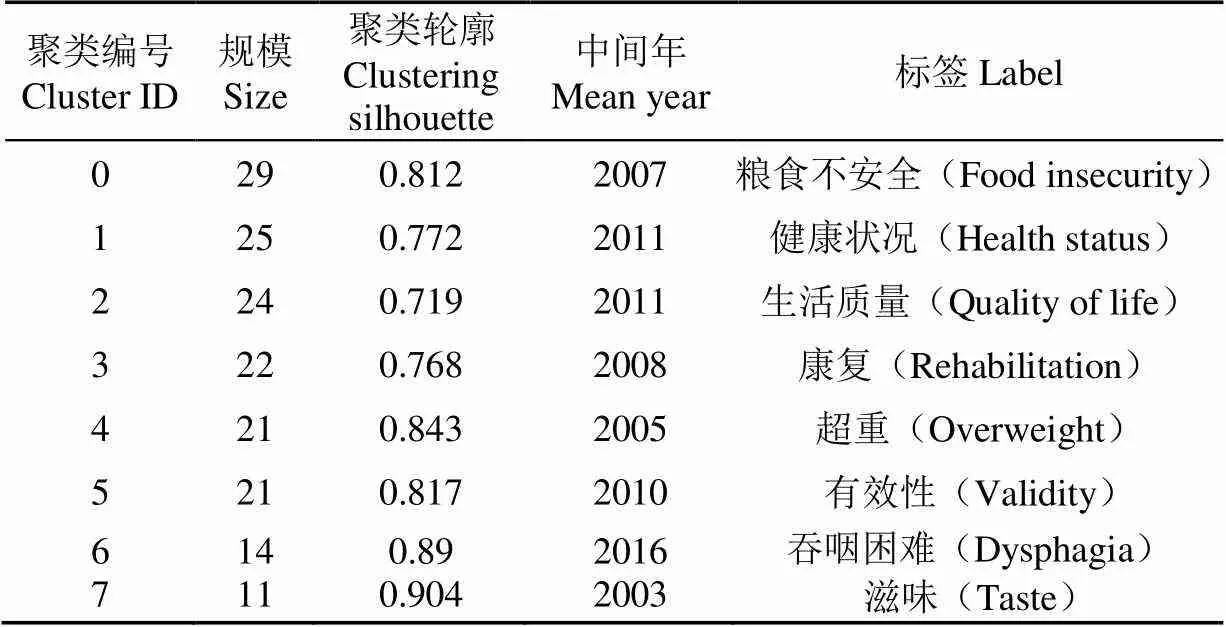基于Web of Science文献计量学分析的全球老年食品研究进展
2021-05-12田华,陈杰
田 华,陈 杰
基于Web of Science文献计量学分析的全球老年食品研究进展
田 华1,陈 杰2
(1. 信阳师范学院生命科学学院,信阳 464000;2. 信阳师范学院马克思主义学院,信阳 464000)
为深入了解国内外老年食品的研究现状和研究热点,该研究基于Web of Science核心合集(SCI-E)数据库,采用文献计量学理论和可视化分析技术,对1990~2020年全球老年食品研究文献进行分析,以为中国老年食品的研究和开发提供参考。全球有 64个国家/地区、852个研究机构,236种期刊开展了老年食品研究,跨区域合作、多学科交叉融合频繁,美国、日本、法国、加拿大、中国等国家均表现出较大的研究体量和较强的合作关系,美国、荷兰老年食品研究的总体质量较高,优势研究机构大多位于欧美等发达国家,研究领域主要集中于营养学、食品科学技术、老年医学等,重点关注膳食补充、健康状况和相关风险。研究前沿有粮食不安全(food insecurity)、健康状况(health status)、生活质量(quality of life)、康复(rehabilitation)、超重(overweight)、有效性(validity)、吞咽困难(dysphagia)、滋味(taste)等。中国老年食品以糊粉类为主,分类混乱、结构单一、科技含量低,与美国、日本、荷兰等国相比还有较大的差距。中国作为世界上人口最多的国家,在人口老龄化加速发展的关键时期,老年食品的研发显得尤为迫切和重要。因此,未来老年食品研究应以老年医学和营养学理论为基础,重点开发营养强化食品和功能性食品,加强食品的感官修饰研究力度,以满足老年人营养和健康的多元化需求,积极应对全球人口老龄化问题。
营养;健康;老年食品;文献计量学;Web of Science;可视化
0 引 言
根据《世界人口展望》(2015年修订版)的数据,2015-2030年,全球60岁及以上人口预计将增长56%,即从9.01亿增至14亿。到2050年,全球老年人口预计将达到21亿[1]。据中国国家统计局数据,2018年中国60周岁及以上人口约为2.5亿,预计到2050年约有5亿,患慢性病老年人将超过1.8亿[2]。随着年龄的增长,老年人因身体衰老造成了心理[3]、生理[4]和认知变化[5-6],比如视力[7]、味觉[8]、嗅觉[9]和运动功能[10]等感官功能下降,同时代谢能力降低带来的器官损伤,尤其是牙齿部分缺失、磨损严重以及咀嚼、吞咽困难导致消化吸收差[11],从而导致营养不良,加速了老年人身体的衰老进程[12-13],增加了老年痴呆等多种疾病和死亡的风险。合适的营养是健康老龄化一个关键的决定因素,大多数与年龄相关的疾病都可以通过恰当的营养干预和食用富含抗氧化剂的食物来预防[14-15]。中国作为世界上人口最多的国家,在老龄化加速发展的关键时期,加快研究和开发老年食品,改善和提高老年人的营养健康状况,事关国家发展全局,事关亿万百姓福祉。
关于老年人的食品种类繁多,老年食品、特医食品、特殊食品、营养强化食品、特膳食品[16]、保健食品[17]等名词风靡于网络。据2018年《食品安全国家标准·老年食品通则》(征求意见稿)[18]指出,老年食品是指经改善食物物理性状和(或)调整膳食(营养)成分的种类及含量,以适应咀嚼和(或)吞咽功能下降、营养不良老年人生理特点,满足其饮食需要或营养需求的一类特殊膳食用食品,包括易食食品、老年营养配方食品、老年营养补充食品三类。由此可见,老年食品应具有一定的调节和改善人体生理和病理的作用,还应具有营养、安全和感官上满足人体的基本属性。美国、德国已根据不同年龄段老年人及慢性病的需求,开发了从主食到饮品的全套老年食品[19]。日本针对老年人的照护食品有专门分类[20-21],如适合咀嚼困难老年人的咖喱肉,适合吞咽功能下降老年人的果冻,以及用变色口香糖检测口腔咀嚼功能等。食品行业是老龄化人口需求和消费的重要领域,如何科学合理地发展老年食品是积极应对人口老龄化的重要举措。中国老年食品以冲调糊粉类食品为主,分类混乱、结构单一、科技含量低[22],国内对此深入研究的机构和成果较少。因此,有必要对全球老年食品研究进行全面梳理,揭示该领域的研究热点和前沿方向,进而寻求国家、研究机构和作者之间的深度合作,以对中国当前及未来老年食品研究和开发提供参考。
文献计量学[23]是采用数学和统计学的计量方法,研究文献情报的分布结构、数量关系、变化规律和定量管理,从而评价和预测科学技术的研究现状与发展趋势,可以实现大规模文献的时空分析,有着传统文献综述难以比拟的优势。有关食品大数据[24]、营养基因组学[25]、食品废弃物[26]、全球气候变化[27]、全球生物质炭[28]等文献计量分析,已有相关报道,但基于老年食品的文献计量学分析还没有相关报道。因此,本文基于Web of Science核心合集(SCI-E)数据库,采用文献计量学的原理和可视化分析技术,对全球老年食品研究领域文献的时间趋势、国家/地区影响力、研究机构影响力、研究机构合作关系、研究热点和前沿进行分析,梳理和总结1990~2020年全球老年食品研究发展的态势,以对中国老年食品的研究和开发提供参考。
1 材料与方法
通过Web of Science平台Science Citation Index Expanded (SCI-EXPANDED)数据库,以“Food for Elderly People”、“Food for the Aged”、“Geriatric Foods”、“Elderly Foods”、“Aged-food”,对1990-2020年30年间发表的老年食品研究文献进行标题检索,文献语种为English,检索时间为2020年9月16日,共检索得到64个国家/地区发表的587篇文献,其中期刊论文399篇、会议摘要141篇、会议记录文件27篇、评论19篇、编辑材料13篇、通讯10篇。借助文献计量在线分析平台(https://bibliometric.com)开展国家/地区老年食品领域研究的合作关系分析,借助在线词云图绘制平台(https://wordart.com/)绘制词云图,采用美国Drexel大学陈超美博士开发的CiteSpace可视化分析软件,对研究文献关键词进行聚类分析。
2 结果与分析
2.1 年度发文量分析
1990-2020年全球老年食品研究领域共发表论文587篇,美国148篇,日本50篇,荷兰45篇排名前三,中国以13篇居于第14名(图1)。
美国从1990年发表第1篇老年食品领域研究论文[29]以来,研究论文发表的数量呈螺旋式增加,在2001-2003年左右达到峰值,而近10年速度放缓,反而日本老年食品领域研究成果势头强劲。2019年度,全球老年食品研究领域论文共计发表40篇,美国、日本、荷兰分表是5、9和4篇,中国无相关论文发表,1990-2020年中国仅发表13篇,于2003年实现零的突破。很明显,中国在老年食品研究领域显著落后于美日等发达国家,这与中国日益严峻的老龄化形势极不相符。
2.2 发文国家/地区分析
图2是1990-2020年全球老年食品研究领域文献主要国家/地区分布。全球有 64个国家/地区开展了老年食品研究,论文发表2篇以上的国家/地区有46个,排名前10的国家/地区依次为美国(USA)、日本(Japan)、荷兰(Netherlands)、英国(England)、法国(France)、巴西(Brazil)、西班牙(Spain)、加拿大(Canada)、意大利(Italy)、韩国(South Korea),发文量分别占总发文量的25.21%、8.52%、7.67%、7.50%、6.13%、4.94%、4.77%、4.60%、4.26%、3.92%(图2)。发文量居前10的国家全部是世界发达国家,尤其是美国占有绝对优势,发文总量占全球发文总量的1/4,超过日本、荷兰和英国三国的总和。这表明全球老年食品领域研究相对集中,各国仍与美国存在不小的差距。
相对于SCI论文发表数量而言,文献的被引次数更能反映出文章的质量和影响力。从h-指数、总被引次数、篇均被引次数来看(图2),尽管美国在SCI论文发表数量、h-指数、总被引次数上遥遥领先,亚洲的日本、欧洲荷兰、英国、法国等国还有不小的差距。但从篇均被引次数来看,西班牙、挪威、荷兰、瑞典4国已经超过美国。中国30年间老年食品研究SCI论文共发表13篇,分别占全球和美国发文总量的2.21%、8.78%;h指数8,总被引次数181,篇均被引次数13.92,而这4个指标美国分别为148、33、3745、25.3。这也表明中国老年食品研究领域高质量论文的发表数量还较少,与美国、日本等发达国家相比差距还比较大。
2.3 发文机构分析
表1是1990-2020年全球老年食品研究领域主要研究机构文献分布及分析指标。从表1发表论文数量排名来看,论文发表最多的研究机构是巴西圣保罗大学,其次是加拿大蒙特利尔大学和法国斯特拉斯堡大学。排名前9的机构中,巴西2所,加拿大2所,法国2所,其次是日本、荷兰、以色列。此9所机构大多位于欧美等发达国家,但没有美国研究机构。从表1总被引次数排名来看,排名前9的研究机构中,美国有3所,分别是杜克大学、密歇根大学和康奈尔大学,是入围机构最多的国家;荷兰2所,日本、法国、西班牙、英国研究机构各1所。综合表1分析,发文数量和总被引次数突出的都是世界传统名校或研究院,最典型的国家有巴西和美国,巴西以2个研究机构发表论文多而突出,而美国的三所研究机构虽然在论文发表数量不占优势,却在总被引次数方面特别突出,这与这些大学开展老人学、健康学、营养学、健康行为与健康教育、食品科学与技术等专业密切相关。

表1 1990-2020年全球老年食品研究领域主要研究机构
2.4 国际合作分析
图3是1990-2020年全球老年食品研究国家/地区研究机构合作关系。全球老人食品研究领域发表SCI论文的国家/地区有64个,852个研究机构,236种期刊。从图3a可以看出,国家/地区间开展密切的合作研究,跨区域合作频繁。美、日、法、加、中等国均表现出较大的研究体量和合作关系,其中日本与美国、瑞典、意大利、英国、中国、澳大利亚等国均有合作关系。从图3b可以看出,全球老年食品研究国家/地区研究合作机构形成2个最密切的合作关系网络,分别是以德国的伯恩大学、莱比锡大学、慕尼黑工业大学等10多所研究机构形成的德国国内合作机构网络(A),以及希腊雅典大学、瑞士洛桑大学、奥地利因斯布鲁克大学等10多个国家形成的国际合作机构网络(B)。中国的合作关系网络相对较弱,合作国家包括美国、法国、英国、澳大利亚、日本、芬兰、波兰等,中国科学院、湖北工业大学与日本的早稻田大学、三重大学、上智大学、日本红十字会武藏野医院、日本冈山县立大学、昭和女子大学,以及波兰卢布林生命科学大学形成了最大的一个合作网络;其次是浙江工商大学、芬兰农业资源研究所、波兰罗兹医科大学等45家研究机构共同参与形成的合作网络。
2.5 研究领域分析
近30年来,全球老年食品研究涉及的主要领域有营养学、食品科学技术、老年医学、生物化学与分子生物学、内分泌代谢、细胞生物学、生物医学、公共环境职业卫生等,其中营养学研究文献占比达到46.2%,其次是食品科学技术和老年医学,研究文献占比均达到13%。具体到美国、日本、荷兰和中国四国研究领域,从图4可以看出,美国偏重于营养学、生物化学与分子生物学、细胞生物学,日本、荷兰和中国均偏重于营养学、食品科学技术、老年医学,荷兰行为科学研究文献也较多,其他研究方向如药理学、神经学、心理学、免疫学、生理学、精神病学等,也产生了系列研究文献,呈现跨领域、多学科交叉融合的研究特点。
2.6 研究热点与研究前沿
2.6.1 研究热点分析
图5是1990-2020年全球老年食品研究主要关键词年度分布。从图5可以看出,出现频次最高的关键词依次是Elderly(老年人)、Nutrition(营养)、Food frequency questionnaire(饮食频率调查问卷)。近3年,关键词Malnutrition(营养不良)、Aged(衰老)、Texture(质地)、Nutritional status(营养状况)词频数稳步增长。
通过分析老年食品研究领域关键词的突现性(表2),发现自1990年提出老年食品概念后,直到1993年才有关键词的突现。2000年前,全球老年食品研究共发表122篇文献,关键词突现很少,仅有关键词老年人(Elderly,1993)、滋味(Taste,1996)、营养摄入(Nutrient intake,1997)。在此期间,营养学、生物化学与分子生物学、生物学、细胞生物学、行为科学研究成为重点,研究者着重关注老年食品的滋味与营养素摄入。自2000年以来,全球老年食品研究共发表465篇文献,突现的关键词逐年增加,饥饿(Hunger,2001)、寿命(Age,2002)、补充(Supplementation,2003)、风险(Risk,2006)、人(People,2008)、健康(Health,2011)、水果(Fruit,2012)、消费(Consumption,2014),研究主要集中在营养学、食品科学技术、老年医学、内分泌代谢、生物化学与分子生物学领域,重点关注膳食补充、健康状况和相关风险。

表2 1990-2020年全球老年食品研究领域文献突现分析
2.6.2 研究前沿分析
通过CiteSpace文献共被引分析,获取全球老年食品研究共被引聚类图谱(图6),分析表明全球老年食品研究前沿主要集中在#0粮食不安全(food insecurity)、#1健康状况(health status)、#2生活质量(quality of life)、#3康复(rehabilitation)、#4超重(overweight)、#5有效性(validity)、#6吞咽困难(dysphagia)、#7滋味(taste)8个方面。图6和表3表明#0粮食不安全(food insecurity)、#1健康状况(health status)组成2个最大的聚类。#0粮食不安全(food insecurity)是最大的聚类,包含29个成员。#6吞咽困难(dysphagia)是最新的聚类,包含14个成员,表明未来老年食品的研究趋势和研究方向。
吞咽过程中的任何中断都可以定义为吞咽困难[30]。吞咽困难,又称吞咽问题或吞咽障碍,它不是一种疾病,而是多种不同疾病过程的结果[31]。吞咽困难在老年人中很普遍[32],被认为是当前和未来老年医学中的一个重要和严重的问题,因为吞咽困难会导致严重的并发症,如营养不良、脱水、呼吸道感染、吸入性肺炎、再入院、住院和死亡率增加等[33-34]。吞咽困难与营养不良显著相关[35],吞咽困难会导致营养相关的肌肉减少,增加不良后果的风险[36],吞咽困难病人的诊断和康复已成为亟须解决的问题[37-38]。

表3 共被引聚类标签
3 讨 论
当前全球老龄化趋势日益严峻,世界发达国家大多已进入老龄化社会,日本、德国和意大利是世界上老龄化最严重的三个国家。中国于1999年进入老龄化社会[39-40],当前处于老龄化加速发展期[41]。1992年,第47届联合国大会确定1999年为“国际老人年”,表明老龄化问题已经引起了全球关注[42-43]。2001年6月,首届国际老年衰老与营养学术会议在法国巴黎国际会议中心召开,是老年医学在衰老、营养、健康相关领域研究与发展的重要标志[44]。2020年8月,国际顶尖学术期刊《自然》和《柳叶刀》分别设立衰老研究子刊《自然·衰老》与《柳叶刀·健康长寿》,这表明全球应对老龄化问题已经非常迫切[45]。中国国家卫生和计划生育委员会等多部门也于2017年联合发布《“十三五”健康老龄化规划》[46]、《国民营养计划(2017-2030年)》[47],开展老年人群营养改善行动,“建立满足不同老年人群需求的营养改善措施,开发适合老年人群营养健康需求的食品产品,促进健康老龄化”。
共被引聚类分析表明,未来全球老年食品研究前沿主要集中在粮食不安全、健康状况、生活质量、康复、超重、有效性、吞咽困难、滋味8个方面,尤其是吞咽困难,老年人是高发群体,吞咽困难已成为世界各国所面临的重大健康问题。老年人衰老通常表现为身体的骨量、瘦体重和含水量减少,唾液、胃液、胰液、胰岛素和胆汁分泌减少,脂肪量增加[48-49],进而机体可能会出现蠕动减慢导致的便秘,也可能出现吞咽困难或吞咽食物困难,以及味觉、口渴和嗅觉的感知下降[50],以及味蕾减少引起的味觉功能障碍与阿尔茨海默病、糖尿病和精神障碍等相关疾病[51-52]。因此,未来老年食品的开发可以从以下3个方面着手:1)营养强化。由于老年人基础代谢和体力活动的减少,老年人需要较低的能量、更高的蛋白质含量来保持肌肉质量[53-54],以及更多的维生素、矿物质和微量元素等必需的微量营养素来保持良好的骨骼健康[55]。欧洲临床营养和代谢学会(European Society for Clinical Nutrition and Metabolism, ESPEN)建议,有营养不良风险的老年人应接受营养强化食品[56]。老年人可根据自己身体需要和膳食状况,在营养科医师和专病医师的指导下,选择适合自己的强化食品或营养素补充制剂[57-58],做到食物多样,安全足量,合理营养。2)功能性食品。随着年龄的增长,老年人对能量和多种营养物质的需求以及食欲都有所下降,有必要为老年人生产富含抗氧化剂(维生素A、C和E以及类黄酮等)、ω-3多不饱和脂肪酸、植物雌激素(异黄酮、香豆素和木脂素等)、类胡萝卜素(-和-胡萝卜素、叶黄素和玉米黄质等)、番茄红素、多酚、膳食纤维,以及添加益生元的益生菌类等功能性食品[59-60],以达到预防或降低老年人饮食相关疾病风险的愿望[61]。比如,食用富含植物甾醇和甾烷醇的功能性食品,具有降低老年人血浆总胆固醇的潜力,从而预防老年人心血管疾病[62]。3)感官修饰。对于因年老或服用药物而导致味觉、嗅觉功能降低,甜味、咸味等口味阈值升高的老年人,可以在食品中添加香料、草药等增味剂、着色剂来增强食品的感官特性以刺激食欲[63-64]。对于吞咽困难的老年人,可以修改食品质地(泡沫、浸泡或增稠)、温度、体积或黏度,选择软食、进食中要细嚼慢咽、预防呛咳和误吸[65-66]。同时,提高烹饪标准也非常必要[67],老年人也需要色香味俱全的食品,份量、能量和蛋白质含量以及老年人的偏好、食品包装、就餐环境等也是需要考虑的因素[68]。此外,鉴于老年人大多具有多种慢性病需要常年服药,老年食品的开发还要考虑营养物质之间、常用药物和营养物之间可能产生的化学相互作用[69-70]。
4 结 论
本文采用文献计量学和可视化分析方法,对1990~2020年Web of Science核心合集(SCI-E)数据库发表的老年食品研究领域文献进行综述,主要结论有:
1)从学术综合影响力来看,1990-2020年全球有64个国家/地区、852个研究机构,236种期刊开展了老年食品的研究。美国、荷兰老年食品研究的总体质量较高,日本、法国、西班牙等国家也比较突出,优势研究机构全部位于欧美等发达国家,美国、日本、法国、加拿大、中国等国家均表现出较大的研究体量和较强的合作关系,涉及的主要研究领域有营养学、食品科学技术、老年医学、生物化学与分子生物学、内分泌代谢等,研究领域呈现跨领域、多学科交叉融合的特点。中国1990-2020年老年食品研究领域共计发表论文13篇,于2003年实现零的突破,与美国、日本、荷兰等发达国家相比还有较大的差距。
2)从研究热点和研究前沿来看,全球老年食品研究重点关注膳食补充、健康状况和相关风险,未来全球老年食品研究前沿主要集中在粮食不安全(food insecurity)、健康状况(health status)、生活质量(quality of life)、康复(rehabilitation)、超重(overweight)、有效性(validity)、吞咽困难(dysphagia)、滋味(taste)等。
综上,国内外学者关于老年食品进行了很多有益的探索研究。相较于国外而言,国内老年食品研究还处于起步阶段,分类混乱、结构单一、科技含量低。因此,中国未来老年食品的研究应以老年医学和营养学理论为基础,开展老年人对营养健康食品的信任差异、认知差异、功能需求、产品形态偏好、口味偏好等大规模调查,重点开发营养强化食品和功能性食品,加强食品质构、食品包装、食品分级、食品评价等感官修饰研究力度,以满足健康或失能等不同层次老年人营养和健康的多元化需求,积极应对全球人口老龄化。
[1] Damanpreet K, Prasad R, Jyoti S, et al. Nutritional interventions for elderly and considerations for the development of geriatric foods[J]. Current Aging Science, 2019, 12(1): 15-27.
[2] 高阳. 老年食品想吃买不着[N].生命时报,2020-01-18(7).
[3] van den Heuvel E, Newbury A, Appleton K M. The psychology of nutrition with advancing age: focus on food neophobia[J]. Nutrients, 2019, 11(1): 151.
[4] Mercer J G, Johnstone A M, Halford J C G. Approaches to influencing food choice across the age groups: From children to the elderly[J]. Proceedings of the Nutrition Society, 2015, 74(2): 149-157.
[5] Okamoto S, Kobayashi E, Murayama H, et al.Decomposition of gender differences in cognitive functioning: National Survey of the Japanese elderly[J]. BMC Geriatrics, 2021, 21(1): 38.DOI: 10.1186/s12877-020-01990-1
[6] Koyama S, Komatsu T, Ishiyama D, et al. Impact of physical, cognitive, and psychological functions on incident homebound status after discharge among hospitalized older patients: A clinical based prospective study[J]. Archives of Gerontology and Geriatrics, 2021, 92:104258.
[7] Effendi-Tenang I, Tan M P, Khaliddin N, et al. Vision impairment and cognitive function among urban-dwelling malaysians aged 55 years and over from the malaysian elders longitudinal research study[J].Archives of Gerontology and Geriatrics, 2020, 90: 104165.
[8] Ogawa T, Uota M, Ikebe K, et al. Longitudinal study of factors affecting taste sense decline in old-old individuals[J]. Journal of Oral Rehabilitation, 2017, 44(1): 22-29.
[9] SanfordAM. Anorexia of aging and its role for frailty[J]. Current Opinion in Clinical Nutrition and Metabolic Care, 2017, 20(1): 54-60.
[10] Rayner C K, MacIntosh C G, Chapman I M, et al. Effects of age on proximal gastric motor and sensory function[J]. Scandinavian Journal of Gastroenterology, 2000, 35(10): 1041-1047.
[11] Mioche L, Bourdiol P, Peyron M A. Influence of age on mastication: Effects on eating behaviour[J]. Nutrition Research Reviews, 2004, 17(1): 43-54.
[12] van de Rest O, Schutte BAM, Deelen J, et al. Metabolic effects of a 13-weeks lifestyle intervention in older adults: The Growing Old Together Study[J]. Aging-us, 2016, 8(1): 111-126.
[13] Mendez M A, Newman A B. Can a mediterranean diet pattern slow aging?[J]. The Journals of Gerontology Series A Biological Sciences and Medical Sciences, 2018, 73(3): 315-317.
[14] Kaur D, Rasane P, Singh J, et al. Nutritional interventions for elderly and considerations for the development of geriatric foods[J]. Current Aging Science, 2019, 12(1): 15-27.
[15] Szakos D, Ozsvari L, Kasza G. Perception of older adults about health-related functionality of foods compared with other age groups[J]. Sustainability, 2020, 12(7): 2748. DOI: 10.3390/su12072748
[16] 梁栋. 第41届营养与特殊膳食食品法典委员会会议进展[J]. 中国食品卫生杂志,2020,32(3):345-347.
[17] 周佳. 保健食品标准体系解读[N]. 中国市场监管报,2020-09-17(008).
[18] 我国发布首个老年食品国家标准[N]. 老年日报,2018-9-20(1).
[19] Chao S Y, Dwyer J T, Houser R F, et al. Experts stress both wellness and amenity aspects of food and nutrition services in assisted living facilities for older adults[J]. Journal of the American Dietetic Association, 2008, 108(10): 1654-1661.
[20] Hase T, Miura Y, Nakagami G, et al. Food bolus-forming ability predicts incidence of aspiration pneumonia in nursing home older adults: A prospective observational study[J]. Journal of Oral Rehabilitation, 2019, 47(1): 53-60.
[21] Wada S, Kawate N, Mizuma M. What type of food can older adults masticate? evaluation of mastication performance using color-changeable chewing gum[J]. Dysphagia, 2017, 32(5): 636-643.
[22] 王健,赵抒娜,申海云. 老年食品发展现状及研发方向探讨[J]. 现代食品,2019(24):45-47.
Wang Jian, Zhao Shuna, Shen Haiyun. Discussion on the current situations and research directions of geriatric foods[J]. Modern Food, 2019(24): 45-47. (in Chinese with English abstract)
[23] 邱均平. 文献计量学[M]. 北京:科学出版社,2019.
[24] 骆靖阳,陆柏益. 基于文献计量学的食品大数据技术研究分析[J]. 食品科学,2021,42(5):278-287.
Luo Jingyang, Lu Baiyi. Research and analysis of food big data technology based on bibliometrics[J]. Food Science. 2021,42(5):278-287. (in Chinese with English abstract)
[25] 许智勇,马爱民. 基于文献计量的全球营养基因组学研究态势分析[J]. 食品科学,2020,41(5):237-245.
Xu Zhiyong, Ma Aimin. Global trends in nutrigenomic research: A bibliometric analysis[J]. Food Science, 2020, 41(5): 237-245. (in Chinese with English abstract)
[26] Chen H, Jiang W, Yang Y, et al. State of the art on food waste research: A bibliometrics study from 1997 to 2014[J]. Journal of Cleaner Production, 2016, 140(s1): 840-846.
[27] Sharifi A, Simangan D, Kaneko S. Three decades of research on climate change and peace: A bibliometrics analysis[J/OL]. Sustainability Science, [2020-01-15] https://doi.org/10.1007/ s11625-020-00853-3
[28] 肖鹏飞,安璐,吴德东. 基于文献计量学分析的全球生物质炭研究进展[J]. 农业工程学报,2020,36(18):292-300.
Xiao Pengfei, An Lu, Wu Dedong. Research progress of biochar in the world based on bibliometrics analysis[J]. Transactions of the Chinese Society of Agricultural Engineering (Transactions of the CSAE), 2020, 36(18): 292-300. (in Chinese with English abstract)
[29] Chau P, Lee H S, Tseng R, et al. Dietary habits, health beliefs and food practices of elderly Chinese women[J]. Journal of the American Dietetic Association, 1990, 90(4): 579-580.
[30] Crary M, Groher M. Introduction to adult swallowing disorders[J]. Plos Computational Biology, 2003, 8(7): e1002587.
[31] Zhang M Q, Li C, Zhang F, et al. Prevalence of dysphagia in China: An epidemiological survey of 5943 participants[J/OL]. Dysphagia, [2020-01-15] https://doi.org/10.1007/s00455-020- 10138-7
[32] Park J W, Lee S, Yoo B, et al. Effects of texture properties of semi-solid food on the sensory test for pharyngeal swallowing effort in the older adults[J]. BMC Geriatrics, 2020(1): 493. DOI: 10.1186/s12877-020-01890-4
[33] Clave P, Shaker R. Dysphagia: Current reality and scope of the problem[J]. Nature Reviews Gastroenterology & Hepatology, 2015, 12(5): 259-270.
[34] Baijens L W, Clave P, Cras P, et al. Eeuropean society for swallowing disorders-european union geriatric medicine society white paper: Oropharyngeal dysphagia as a geriatric syndrome[J]. Clinical Interventions in Aging. 2016, 7(11): 1403-1428.
[35] Tagliaferri S, Lauretani F, Pela G, et al. The risk of dysphagia is associated with malnutrition and poor functional outcomes in a large population of outpatient older individuals[J]. Clinical Nutrition, 2018, 38(6): 2684-2689.
[36] Wakabayashi H. Presbyphagia and sarcopenic dysphagia: association between aging, sarcopenia, and deglutition disorders[J]. The Journal of Frailty Aging 2014, 3(2): 97-103.
[37] Hadde E K, Chen J S. Texture and texture assessment of thickened fluids and texture-modified food for dysphagia management[J]. Journal of Texture Studies, 2021, 52(1): 4-15.
[38] 陈建设,陈勇. 基于食品物理学的老年饮食能力评价与膳食质构等级评测[J]. 中华物理医学与康复杂志,2019(12):945-948.
[39] 刘彦随. 中国新时代城乡融合与乡村振兴[J]. 地理学报,2018,73(4):637-650.
Liu Yansui. Research on the urban-rural integration and rural revitalization in the new era in China[J]. Acta Geographica Sinica, 2018, 73(4): 637-650. (in Chinese with English abstract)
[40] 王金元. 城市老人居家养老的社会支持[J]. 社会科学家,2008(4):110-113.
[41] 王胜今,舒莉. 积极应对我国人口老龄化的战略思考[J].吉林大学社会科学学报,2018,58(6):5-14,203.
[42] Annan K. Address at ceremony launching the international year of older persons (1999).[J]. Journals of Gerontology Series B: Psychological Sciences & Social Sciences, 1999, 54(1): 5-6.
[43] Andrews G, Clark M J. The international year of older persons: Putting aging and research onto the political agenda[J]. Journals of Gerontology Series B: Psychological Sciences & Social Sciences, 1999, 54(1): 7-10.
[44] 陆惠华. 首届国际老年衰老与营养学术大会会议简要[J].老年医学与保健,2001,7(3):157.
[45] 李晨琰. 国际顶尖学术期刊《自然》和《柳叶刀》分别设立衰老研究子刊全球健康老龄化研究按下“快进键”[N].文汇报,2020-08-05(7).
[46] 国家卫生计生委. 关于印发“十三五”健康老龄化规划的通知[EB/OL]. [2017-03-09]. http://www.otcmoh.org.cn/ info/182.html
[47] 国务院办公厅. 国务院办公厅关于印发国民营养计划(2017-2030年)的通知(国办发〔2017〕60号)[EB/OL]. [2017-7-13]. http://www.gov.cn/zhengce/content/2017-07/13/ content_5210134.htm
[48] Jedrusek-Golinska A, Gorecka D, Buchowski M, et al. Recent progress in the use of functional foods for older adults: A narrative review[J]. Comprehensive Reviews in Food Science and Food Safety, 2020, 19(2): 835-856.
[49] St-Onge M P, Gallagher D. Body composition changes with aging: The cause or the result of alterations in metabolic rate and macro-nutrient oxidation?[J]. Nutrition, 2010, 26(2): 152-155.
[50] Sura L, Madhavan A, Carnaby G, et al. Dysphagia in the elderly: Management and nutritional considerations[J]. Clinical Interventions in Aging, 2012, 7: 287-298.
[51] Allis T J, Leopold D A. Smell and taste disorders[J]. Facial Plastic Surgery Clinics of North America, 2012, 20(1): 93-111.
[52] Cruz-Jentoft A J, Woo J. Nutritional interventions to prevent and treat frailty[J]. Current Opinion in Clinical Nutrition and Metabolic Care, 2019, 22(3): 191-195.
[53] Lv Y B, Kraus V B, Gao X, et al. Higher dietary diversity scores and protein-rich food consumption were associated with lower risk of all-cause mortality in the oldest old[J]. Clinical Nutrition, 2020, 39(7): 2246-2254.
[54] Dermiki M , Curran B . Exploring which foods can be used as high protein carriers for adults older than 50 years[C]// Nutrition Society Live 2020. 2020-10-19
[55] Ashong J, Muthayya S, De-Regil L M, et al. Fortification of rice with vitamins and minerals for addressing micronutrient malnutrition[J]. Cochrane Database of Systematic Reviews, 2012,6: CD009902.
[56] Volkert D, Beck A M, Cederholm T, et al. ESPEN guideline on clinical nutrition and hydration in geriatrics[J]. Clinical Nutrition, 2019, 38(1): 10-47.
[57] 中国营养学会.《中国居民膳食指南(2016)》[M]. 北京:人民卫生出版社,2016.
[58] Donahue E, Crowe K M, Lawrence J, et al. Protein-enhanced soups: A consumer-accepted food for increasing dietary protein provision among older adults[J]. International Journal of Food Sciences and Nutrition, 2015, 66(1): 104-107.
[59] Jedrusek-Golinska A , Gorecka D, Buchowski M, et al. Recent progress in the use of functional foods for older adults: A narrative review[J]. Comprehensive Reviews in Food Science and Food Safety, 2020,19(2): 835-856.
[60] Martirosyan D M, Singh J. A new definition of functional food by FFC: What makes a new definition unique?[J]. Functional Foods in Health and Disease, 2015, 5(6): 209-223.
[61] Douglas W, Paul N, Harpal B, et al. The role of food antioxidants, benefits of functional foods, and influence of feeding habits on the health of the older person: An overview[J]. Antioxidants, 2017, 6(4):81.
[62] Gandola A E, Dainelli L, Zimmermann D, et al. Milk powder fortified with potassium and phytosterols to decrease the risk of cardiovascular events among the adult population in malaysia: A cost-effectiveness analysis[J]. Nutrients, 2019, 11(6): 1235.
[63] Pouyet V, Cuvelier G, Benattar L, et al. Influence of flavour enhancement on food liking and consumption in older adults with poor, moderate or high cognitive status[J]. Food Quality and Preference, 2015, 44: 119-129.
[64] Cox N J, Ibrahim K, Sayer A A, et al. Assessment and treatment of the anorexia of aging: a systematic review[J]. Nutrients, 2019, 11(1):144.
[65] Cichero J A Y. Age-related changes to eating and swallowing impact frailty: Aspiration, choking risk, modified food texture and autonomy of choice[J]. Geriatrics, 2018, 3(4): 69.
[66] Payne M, Morley J E. Dysphagia, dementia and frailty[J]. Journal of Nutrition, Health & Aging, 2018, 22(5): 562-565.
[67] Hunter, W, Worsley T. Understanding the older food consumer. present day behaviours and future expectations[J]. Appetite, 2009, 52(1): 147-154.
[68] Song X, Giacalone D, Johansen S M B, et al. Changes in orosensory perception related to aging and strategies for counteracting its influence on food preferences among older adults[J]. Trends in Food Science & Technology, 2016, 53: 49-59.
[69] Di Minno A, Frigerio B, Spadarella G, et al. Old and new oral anticoagulants: Food, herbal medicines and drug interactions[J]. Blood Reviews, 2017, 31(4): 193-203.
[70] Radwan A, Sweileh A, Shraim W, et al. Evaluation of community pharmacists' knowledge and awareness of food-drug interactions in Palestine[J]. International Journal of Clinical Pharmacy, 2018, 40(3): 668-675.
Research progress of global foods for elderly based on bibliometric analysis of Web of Science
Tian Hua1, Chen Jie2
(1.,,464000,; 2.,,464000,)
Most of developed countries have entered the aging society in the world, and the global aging is increasingly serious. China entered in 1999, and now is in the accelerated development period. For successful aging, appropriate nutrition is a major determinant. Most age-related diseases can be prevented by taking appropriate nutritional interventions and eating foods rich in nutrients and antioxidants. In order to provide a reference for the current and future research and development in China, a comprehensive bibliometric visual analysis of the global elderly food research based on the Web of Science database from 1990 to 2020 was applied to reflect scientific influences and capabilities of relevant countries, understand the in-depth cooperation between countries, research institutions and authors, then to reveal the research hotspots and frontiers. The results showed that the total number of publications increases substantially in recent years, suggesting that more and more researchers have begun to pay attention to this field. A total of 64 countries or regions, 852 research institutions and 236 journals have carried out researches in this field. The United States is the major contributor to this research in the world. In addition, Japan, Netherlands, England, France, Brazil, Spain and other countries have also conducted in-depth research. Especially Spain, Norway, Netherlands and Sweden have surpassed the United States according to the number of citations per article. For China, high-quality research is still relatively rare. There is a huge gap between China and countries with better research. The University of Sao Paulo in Brazil is the most published research institution, and Duke University in the United States is the most cited institution in the world, both of which are all world-famous universities in history. It appears that most of the major research institutions are located in developed countries of Europe and America. At the same time, research institutions are very closely linked, and cross-regional cooperation and interdisciplinary integration are frequent. Two closest cooperation networks are very clear. The first is the network of Germany cooperation organization formed by more than ten institutions, such as University of Bonn, University of Leipzig and Technical University of Munich. The second the network of international cooperation organization formed by more than ten countries or regions, such as University of Athens in Greece, University of Lausanne in Switzerland and University of Innsbruck in Austria. The cooperation network in China is relatively weak, including the United States, France, England, Australia, Japan, Finland, Poland, etc. The main fields of global elderly food research are nutrition dietetics, food science and technology, geriatric gerontology, biochemistry and molecular biology, focusing on dietary supplement, health status and related risks. As the largest population country in the world, the research and development of the elderly foods are urgent and important in the period of accelerated aging development. The future research should be focused on the development of nutrient fortified food and functional food, strengthened the research on sensory modification based on the theory of geriatrics and nutrition, so as to meet the diversified nutritional needs of the elderly in respond to the global aging.
nutrition; health; elderly foods; bibliometrics; Web of Science; visualization
田华,陈杰. 基于Web of Science文献计量学分析的全球老年食品研究进展[J]. 农业工程学报,2021,37(5):324-332.doi:10.11975/j.issn.1002-6819.2021.05.038 http://www.tcsae.org
Tian Hua, Chen Jie. Research progress of global foods for elderly based on bibliometric analysis of Web of Science[J]. Transactions of the Chinese Society of Agricultural Engineering (Transactions of the CSAE), 2021, 37(5): 324-332. (in Chinese with English abstract) doi:10.11975/j.issn.1002-6819.2021.05.038 http://www.tcsae.org
2020-12-28
2021-02-06
全国老龄办老龄政策理论研究部级课题(QLB2018A013);信阳师范学院“南湖学者奖励计划”青年项目。
田华,博士,副教授,研究方向为食品营养健康与大数据。Email:xynu0818@163.com
10.11975/j.issn.1002-6819.2021.05.038
TS201.4
A
1002-6819(2021)-05-0324-09
